The ASRock AB350 Gaming K4 Motherboard Review: Dual M.2 at $90
by Gavin Bonshor on April 9, 2018 9:00 AM ESTGaming Performance
Ashes of the Singularity
Seen as the holy child of DirectX12, Ashes of the Singularity (AoTS, or just Ashes) has been the first title to actively go explore as many of DirectX12s features as it possibly can. Stardock, the developer behind the Nitrous engine which powers the game, has ensured that the real-time strategy title takes advantage of multiple cores and multiple graphics cards, in as many configurations as possible.
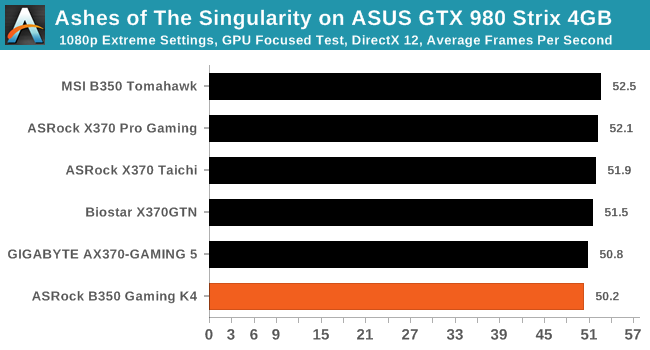
Rise Of The Tomb Raider
Rise of the Tomb Raider is a third-person action-adventure game that features similar gameplay found in 2013's Tomb Raider. Players control Lara Croft through various environments, battling enemies, and completing puzzle platforming sections, while using improvised weapons and gadgets in order to progress through the story.
One of the unique aspects of this benchmark is that it’s actually the average of 3 sub-benchmarks that fly through different environments, which keeps the benchmark from being too weighted towards a GPU’s performance characteristics under any one scene.
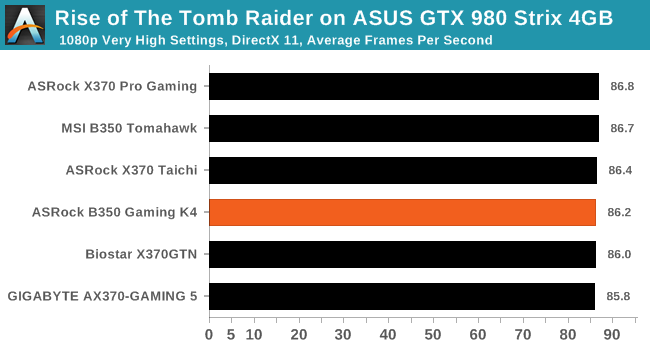
Thief
Thief has been a long-standing title in PC gamers hearts since the introduction of the very first iteration which was released back in 1998 (Thief: The Dark Project). Thief as it is simply known rebooted the long-standing series and renowned publisher Square Enix took over the task from where Eidos Interactive left off back in 2004. The game itself utilises the fluid Unreal Engine 3 engine and is known for optimised and improved destructible environments, large crowd simulation and soft body dynamics.
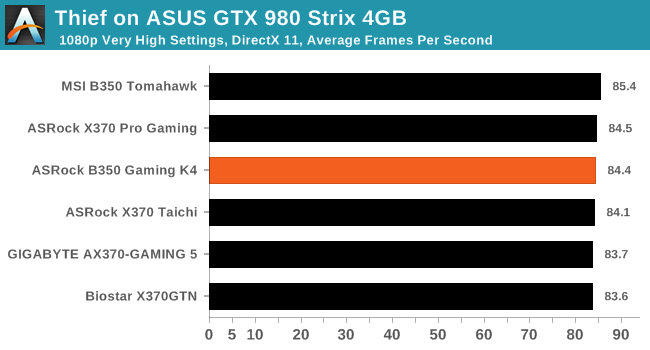
Total War: WARHAMMER
Not only is the Total War franchise one of the most popular real-time tactical strategy titles of all time, but Sega delve into multiple worlds such as the Roman Empire, Napoleonic era and even Attila the Hun, but more recently they nosedived into the world of Games Workshop via the WARHAMMER series. Developers Creative Assembly have used their latest RTS battle title with the much talked about DirectX 12 API so that this title can benefit from all the associated features that comes with it. The game itself is very CPU intensive and is capable of pushing any top end system to their limits.
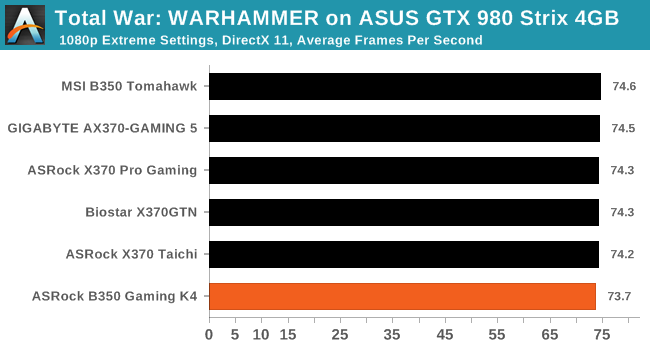




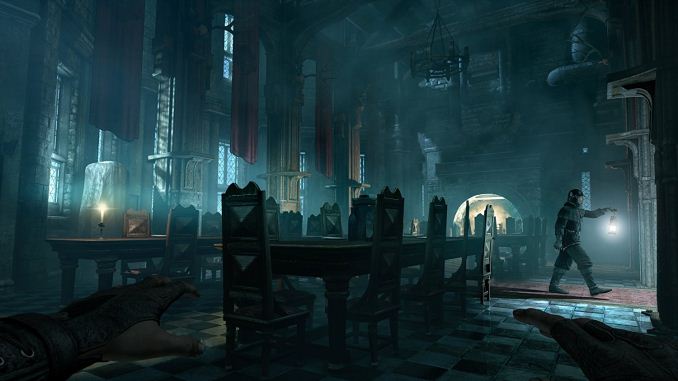
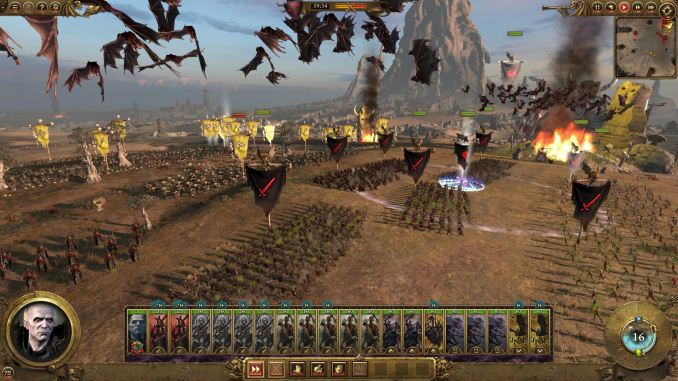








43 Comments
View All Comments
jhensjh - Tuesday, April 10, 2018 - link
Here's a couple typos for a start: "it compounts the issue.", "controllers, which which is to be expected". This article ranges from rambling sentences with excessive comma splices to bordering on nonsensical. An example of the former:"For manual overclocks, based on the information gathered from previous testing, starts off at a nominal voltage and CPU multiplier, and the multiplier is increased until the stability tests are failed."
And the latter:
"This would empty more thermal energy into the heatsinks"
vkristof - Tuesday, April 10, 2018 - link
I want to thank the author for starting to address WHY socket AM4 motherboard manufacturers do not promote/use/whatever the USB 3.1 Gen 2 ports that the AMD chipset supports.However, I assume there's at least one typo in his statement "Despite the chipset supporting USB 3.1 (10 Gbps), ASRock saves some effort in the mode complicated traces by relying on USB 3.0 instead". I assume "mode complicated" should be "MORE complicated" traces. Or?
In addition, why do they plop Asmedia USB 3.1 Gen2 controllers on some of these motherboards to provide gen 2 speeds?
I assume the Asmedia controllers require the same 10+ Gbps differential pair trace routing rules that the B350 chip does. Unless the B350 serdei are less forgiving? Or routing the 10+ Gbps pairs to the high ball count B350 requires more PCB layers?
Anyway, thanks.
Round - Tuesday, April 10, 2018 - link
"If you see any errors or typos, please by all means let us know."LOL. I appreciate the articles, but you've got to be joking, right? You don't see them? They're legion. Besides those already pointed out, take a gander at this gem...
"In regards to the performance, there wasn’t any problems or..."
I'm surprised (and sadly appalled) that it has to be pointed out, but your statement
"Time is fleeting and Google cares more about who's first than who's best..."
is a weak excuse, and nothing more. Anyone can spend 5-10 minutes before publishing. What passes for writing today has me convinced we're ready to collapse into the second coming of the dark ages, where people can't form structured sentences, don't understand tenses, plurals and possessives, or the use of adjectives and adverbs.
Glock24 - Tuesday, April 10, 2018 - link
If this was an article published on the day the media embargo expires for a new product launch I would understand the hurry to publish and lack of proper editing, but this board was launched to the market like a year ago. So why the hurry?Aspernari - Tuesday, May 8, 2018 - link
So a month later, and the editing staff and users haven't managed to catch this:"but this means the onboard audio usese the Realtek RTL8111 networking chip and the Realtek ALC892 audio codec"
A) No, it means the onboard audio is the Realtek ALC892 chipset, and the networking chip is the Realtek RTL8111. We're in deep trouble if the onboard audio is using the RTL8111.
B) It doesn't usese anything. How did that pass basic spellcheck?
PeachNCream - Tuesday, April 10, 2018 - link
Purch generates income from catching and keeping an audience that regularly visits the sites it publishes. It's against the financial interests of the company to drain AnandTech and sell it off when it dies and it's silly to imply that's happening now.In the case of this review, I'm glad to see there are mid-priced motherboards getting a little attention and it's really nice to see something other than a MSI x299 board for once since there's been quite a few of them rolling through of late.
Tewt - Tuesday, April 10, 2018 - link
I thought that must of been a mistake as well. The time for a consumer to research these motherboards that haven't been reviewed yet is nearly over so what is even the point? I had just assumed Anandtech has had a review of the ASRock X370 Taichi board for some time. I will be researching AMD 2000 cpus and 400 series boards in the next few months not older 300 series. /scratches head at Anandtech timelineRyan Smith - Tuesday, April 10, 2018 - link
Let me put things this way: we wouldn't have taken the time to review this board if we didn't think it would be relevant in the future...neogodless - Tuesday, April 10, 2018 - link
That's brilliant! (I've been strongly considering this board and a Ryzen 1700, but I've put it off long enough to wait and see what Ryzen 2xxx brings to the table (and for RAM to, like, not even bankrupt me.) Also I live near Microcenter where this board is just $50 w/ a Ryzen...Ratman6161 - Wednesday, April 11, 2018 - link
Except...one critical thing is missing in the article in the discussion of the 2200g or 2400G. That is that if you buy this motherboard, or any other existing motherboard you are taking a crap shoot on weather you will get a board that has a bios that will support the newer processor. I was considering a 2200g build for my wife until I realized that to make it work, I'd probably have to pull the R51600 out of my system and put it in the new board just so I could update the bios...or give her the motherboard from my system since that's already updated. I decided it would be easier for me to just wait a bit for the newer motherboards to come out.I too live near a Microcenter...gotta love it!